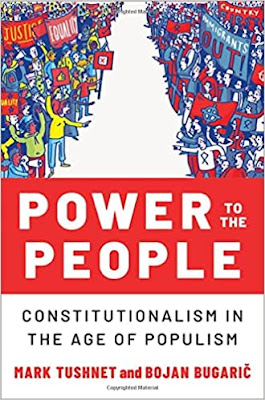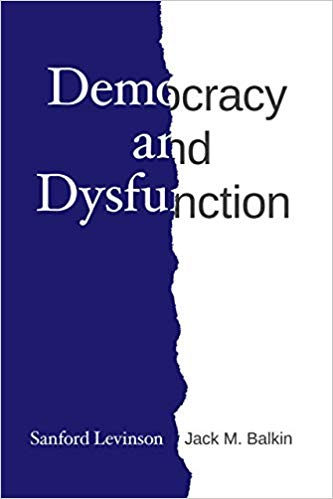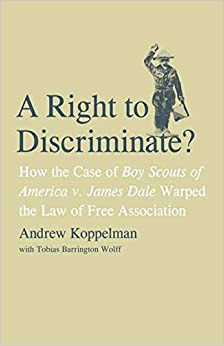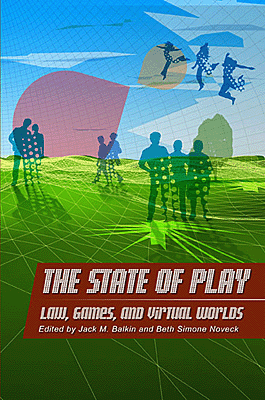Balkinization
an unanticipated consequence of
Jack M. Balkin
Balkinization Symposiums: A Continuing List
E-mail:
Jack Balkin:
jackbalkin at yahoo.com
Bruce Ackerman
bruce.ackerman at yale.edu
Ian Ayres
ian.ayres at yale.edu
Corey Brettschneider
corey_brettschneider at brown.edu
Mary Dudziak
mary.l.dudziak at emory.edu
Joey Fishkin
joey.fishkin at gmail.com
Heather Gerken heather.gerken at yale.edu
Abbe Gluck abbe.gluck at yale.edu
Mark Graber
mgraber at law.umaryland.edu
Stephen Griffin
sgriffin at tulane.edu
Jonathan Hafetz
jonathan.hafetz at shu.edu
Jeremy Kessler
jkessler at law.columbia.edu
Andrew Koppelman
akoppelman at law.northwestern.edu
Marty Lederman
msl46 at law.georgetown.edu
Sanford Levinson
slevinson at law.utexas.edu
David Luban
david.luban at gmail.com
Gerard Magliocca
gmaglioc at iupui.edu
Jason Mazzone
mazzonej at illinois.edu
Linda McClain
lmcclain at bu.edu
John Mikhail
mikhail at law.georgetown.edu
Frank Pasquale
pasquale.frank at gmail.com
Nate Persily
npersily at gmail.com
Michael Stokes Paulsen
michaelstokespaulsen at gmail.com
Deborah Pearlstein
dpearlst at yu.edu
Rick Pildes
rick.pildes at nyu.edu
David Pozen
dpozen at law.columbia.edu
Richard Primus
raprimus at umich.edu
K. Sabeel Rahmansabeel.rahman at brooklaw.edu
Alice Ristroph
alice.ristroph at shu.edu
Neil Siegel
siegel at law.duke.edu
David Super
david.super at law.georgetown.edu
Brian Tamanaha
btamanaha at wulaw.wustl.edu
Nelson Tebbe
nelson.tebbe at brooklaw.edu
Mark Tushnet
mtushnet at law.harvard.edu
Adam Winkler
winkler at ucla.edu
Compendium of posts on Hobby Lobby and related cases
The Anti-Torture Memos: Balkinization Posts on Torture, Interrogation, Detention, War Powers, and OLC
The Anti-Torture Memos (arranged by topic)
Recent Posts
Is Punishment Permissible?
Just A Few Blogs
ACS Blog
Alas, a Blog
Althouse
Arts and Letters Daily
Atrios (Eschaton)
Bill of Health
Buzzflash.com
Buzz Machine
Cato at Liberty
Juan Cole (Informed Comment)
Concurring Opinions
The Constitution in 2020
Corrente
Crooked Timber
Daily Howler
Daily Kos
Dana Boyd
Brad DeLong
Digby (Hullabaloo)
Discriminations
Daniel Drezner
Kevin Drum (Mother Jones)
Electrolite
En Banc
Eunomia (Daniel Larison)
Fafblog
Michael Froomkin (Discourse.net)
GovLab (Beth Noveck)
Rick Hasen (Election Law)
History News Network
How Appealing
Ignatz (Sam Heldman)
The Importance of (Ernie Miller)
Infolaw
Instapundit
International Economic Law and Policy Blog
IntLawGrrls
Jacob Levy
Jesus' General
Jurisdynamics
The Kitchen Cabinet
Mark Kleiman
Law Blog Central
Larry Lessig
Lawyers, Guns and Money
Liberal Oasis
Brian Leiter's Law School Reports
The Leiter Reports
Marginal Revolution
Megan McArdle
Memeorandum
Metafilter
Mirror of Justice
The New Republic
Newseum
No More Mister Nice Blog
Brendan Nyhan
Opinio Juris
Orcinus
The Originalism Blog
Pandagon
Passport (Foreign Policy)
Overcoming Bias
Political Animal (Washington Monthly)
Political Theory Daily Review
Political Wire (Taegan Goddard)
The Poor Man
Virginia Postrel
Prawfsblawg
Public Reason
Jonathan Rauch
Raw Story
Redstate
ReligiousLeftLaw.com
Reporters Committee For Freedom of the Press
Reproductive Rights Blog
Rothman's Roadmap to the Right of Publicity
SCOTUS Blog
Seeing the Forest
Clay Shirky
The Shifted Librarian
The Situationist
Larry Solum (Legal Theory)
Andrew Sullivan
Talking Points Memo
Talk Left
Tapped
Tbogg
TechPresident
The Paper Chase (Jurist)
Tom Paine
Tom Tomorrow (This Modern World)
Eve Tushnet
Uggabugga
University of Chicago Law School Faculty Blog
Unqualified Offerings
The Volokh Conspiracy
War and Piece (Laura Rozen)
Wampum
Oliver Willis
Wonkette
Written Description
Matthew Yglesias
Yin
Your Choice of Feeds
1. XML
powered by
2. Atom Feed
3. RSS 2.0
Is Punishment Permissible?
Guest Blogger
For the Balkinization symposium on Judith Resnik, Impermissible Punishments: How Prison Became a Problem for Democracy (University of Chicago Press, 2025). Judith
Resnik’s important new book, Impermissible
Punishments: How Prison became a Problem for Democracy, sets itself several
tasks and largely accomplishes them. It
lays out a history of the prison, focusing on prison brutality and efforts to
rein it in. It argues that prison brutality
violates our “democratic commitments to treat each person as an equal.” Finally, it proposes a solution: The
anti-ruination principle – the idea that, whatever punishment the government
inflicts on a person, it may not inflict ruin. This
book should be read by every person interested in prison law, and by every
Justice of the Supreme Court. The history it sets forth is fascinating,
disturbing, and ultimately infuriating.
Despite the efforts of many well-intentioned individuals and groups,
incarceration has repeatedly resulted in brutal, dehumanizing treatment of
those subjected to it. Moreover, the
idea of an anti-ruination principle to ameliorate this problem is both morally
and (potentially) legally compelling. But the book raises some fundamental
questions that need answering before the moral can be translated into the
legal. I will focus on some of these and will then propose my own (not entirely
satisfactory) answer. 1.
Are “democratic principles” of equality really the basis for the anti-ruination
principle? Impermissible Punishments seems to treat democracy as a
self-justifying source of a comprehensive moral order. Our commitment to democracy, the argument
goes, requires a commitment to equality. Our commitment to equality requires commitment
to a whole variety of specific policies – not merely policies against brutal
prison conditions, but also policies providing comprehensive social services
both inside and outside prison. This
argument seems to treat democracy as the ultimate ground for moral reasoning –
but it is not. We are not committed to
equality because of our abiding conviction in democracy; rather, we are
committed to democracy because of our conviction in the fundamental dignity and
equality of each individual person. Democracy is the result of moral reasoning,
not the source of it. This
distinction is important because it means we need to look beyond politics to
understand what equality is and how it cashes out in practice. Historically, at
least in Europe and America, the idea of equality and human dignity comes from
the Judeo-Christian belief that every human being is created in the image and
likeness of God. Whatever crime a person has committed, and whatever punishment
he deserves, he still possesses the same core dignity and equality as his
fellow human beings. Slave-holding Athens, the progenitor of democracy in the
West, did not believe in equality in the Judeo-Christian sense. Although Impermissible
Punishments speaks in the language of Athens, its moral commitments seem
to derive more directly from Jerusalem.
And appropriately so, for the Judeo-Christian idea of equality is the
foundation of American democracy (“We hold these truths to be self-evident…”). America’s accommodation of slavery at its
founding and its tolerance (or even encouragement) of various forms of
invidious discrimination ever since shows that we often fail to live up to this
commitment. But if this commitment were
not the foundation of our society, we could not criticize prisons for violating
the anti-ruination principle - for the principle simply wouldn’t apply. Just
as the anti-ruination principle does not derive from the logic of democracy, it
is not inconsistent with other social and political orders. Indeed, Professor Resnik traces the
anti-ruination principle back to Magna Carta, a document from a distinctly hierarchical
and non-democratic society. In
short, both equality and the anti-ruination principle must be based on an
adequate moral anthropology. We cannot
commit to either principle unless we have some idea of who we are as human
beings and why we matter. 2.
What counts as ruination? Is punishment
itself permissible? Impermissible Punishments does not set forth a positive
account of the legitimate purposes of punishment. At one point, the book
references the legitimacy of “seeking public acknowledgement that an individual
has unlawfully intruded on other people.”
Later, it says that “putting some form of confinement in place marks the
radical injuries caused by an individual.”
These descriptions imply that punishment may serve an expressive
purpose, but perhaps not a retributive one.
The book briefly mentions deterrence and incapacitation but does not endorse
them. At
the same time, the book argues that the anti-ruination principle requires that
“prison life should approximate community life” and should “approximate the
normalcy of free movement.” The book
also implies that the government has an affirmative obligation to help
prisoners “thrive outside of prison,” although it rejects the idea of
rehabilitation because it entails working “on” rather than “with” prisoners. This
discussion raises the question of whether punishment is permissible at all
under the proposed anti-ruination principle. Blackstone, for example, made a distinction
between punitive and non-punitive confinement. He wrote that because pretrial
prisoners were held “only for safe custody, and not for punishment,” they “ought to be used with the utmost humanity; and neither be
loaded with needless fetters, or subjected to other hardships than such as are
absolutely requisite for the purpose of confinement only.” American courts also recognize a distinction
between punitive and non-punitive confinement.
If the anti-ruination principle requires that prisoners “ought to be
used with the utmost humanity; and . . . [not] subjected to other hardships
than such as are absolutely requisite for the purpose of confinement only,” is
punishment permissible at all, or merely non-punitive confinement? On the other hand, if the anti-ruination
principle does not prohibit all hardships that are not strictly necessary to
effectuate confinement, where are we to draw the line? 3.
The original meaning of the Cruel and Unusual Punishments Clause I
have argued elsewhere that in the context of the Eighth Amendment, the word
“Cruel” originally meant “unjustly harsh” and “unusual” meant “contrary to long
usage.” A punishment is “cruel and
unusual” if it is unjustly harsh in light of longstanding prior practice. There is no requirement that the punishment
be motivated by cruel intent; the relevant question is whether the punishment
has an unjustly harsh effect. The
baseline for measuring cruelty is neither current societal consensus (as called
for by the evolving standards of decency test) nor the societal consensus of
1790 (as called for in Justice Scalia’s Harmelin opinion). Rather, it is
the consensus of multiple generations, up to and including today, as revealed
through the actions of legislatures, prosecutors, judges and juries. The tradition may develop over time, as some
practices fall out of the tradition and some enter it, but it also maintains a
fundamental continuity. The
normative basis for this approach to deciding questions of cruelty derives from
the common law, which was traditionally called the law of “long use and
custom.” The basic idea was this: We may all agree on core principles of
justice (for example, the equality principle), but it is often difficult to
translate such principles into practice reliably. What counts as cruelty? What counts as ruination? Common law thinkers concluded that the
longstanding customs of a free people were the most reliable way to determine
what practices were just, reasonable, and enjoyed the consent of the
people. Therefore, if a practice was
universally received over a very long period of time, it was legally
enforceable and presumptively just. If a
new practice violated a right established through long usage, on the other
hand, it was considered unjust because it was “unusual.” This mode of thinking provided the
justification for the American Revolution and underlays many of the provisions
of the Bill of Rights. Under
the common law reasoning that underlies the Cruel and Unusual Punishments
Clause, a punishment might constitute “ruination” if its effects are
significantly harsher than those traditionally given for the same or a similar
crime. Because punishments traditionally
involve some infliction of physical or psychological pain, an anti-ruination
principle would not necessarily require that life in prison closely approximate
life in the community, although it certainly would condemn many of the harsh
and degrading prison conditions identified in Impermissible
Punishments. 4.
The problem of prison. That
being said, prison poses a particular problem for the “original meaning”
approach to questions of cruelty. The
normative power of the common law depended on the people having a certain level
of awareness of what the government did to those subjected to punishment. When punishments were inflicted in public,
they were also more likely to be regulated by the public. It is no accident that public pressure to
eliminate the death penalty, for example, largely disappeared when executions
were moved out of the town square and into hidden rooms inside prisons, and
when obviously violent methods like hanging were replaced by scientific-sounding
methods like lethal injection. If people
cannot see the suffering, they are not likely to oppose the suffering. Thus, enforcement of the prohibition of cruel
and unusual punishments depends upon the judiciary being willing to take a
close look at prison conditions to determine whether they meet our traditional
standards. This
leads to the other problem with prisons:
As Impermissible Punishments
shows, the history of incarceration is a long history of experimentation. Most prison practices that might be
challenged under the ruination principle do not enjoy “long usage” – that is,
they have not been universally received over a very long period of time. But the experimentation is so pervasive that
it may be difficult to establish a traditional baseline against which to judge such
practices. Nonetheless, in at least some
instances, comparison is possible. For
example, as I have shown elsewhere, long-term solitary confinement is a
repeated, failed experiment that violates the original meaning of the Cruel and
Unusual Punishments Clause. Doubtless,
many of the practices identified in Impermissible Punishments do so as well. John
Stinneford is a Professor of Law and the Edward Rood Eminent Scholar Chair at
the University of Florida Levin College of Law.
He may be reached at jstinneford@law.ufl.edu.
Posted
9:30 AM
by Guest Blogger [link]
Books by Balkinization Bloggers

Linda C. McClain and Aziza Ahmed, The Routledge Companion to Gender and COVID-19 (Routledge, 2024)

David Pozen, The Constitution of the War on Drugs (Oxford University Press, 2024)

Jack M. Balkin, Memory and Authority: The Uses of History in Constitutional Interpretation (Yale University Press, 2024)

Mark A. Graber, Punish Treason, Reward Loyalty: The Forgotten Goals of Constitutional Reform after the Civil War (University of Kansas Press, 2023)

Jack M. Balkin, What Roe v. Wade Should Have Said: The Nation's Top Legal Experts Rewrite America's Most Controversial Decision - Revised Edition (NYU Press, 2023)

Andrew Koppelman, Burning Down the House: How Libertarian Philosophy Was Corrupted by Delusion and Greed (St. Martin’s Press, 2022)

Gerard N. Magliocca, Washington's Heir: The Life of Justice Bushrod Washington (Oxford University Press, 2022)

Joseph Fishkin and William E. Forbath, The Anti-Oligarchy Constitution: Reconstructing the Economic Foundations of American Democracy (Harvard University Press, 2022)

Mark Tushnet and Bojan Bugaric, Power to the People: Constitutionalism in the Age of Populism (Oxford University Press 2021).

Mark Philip Bradley and Mary L. Dudziak, eds., Making the Forever War: Marilyn B. Young on the Culture and Politics of American Militarism Culture and Politics in the Cold War and Beyond (University of Massachusetts Press, 2021).

Jack M. Balkin, What Obergefell v. Hodges Should Have Said: The Nation's Top Legal Experts Rewrite America's Same-Sex Marriage Decision (Yale University Press, 2020)

Frank Pasquale, New Laws of Robotics: Defending Human Expertise in the Age of AI (Belknap Press, 2020)

Jack M. Balkin, The Cycles of Constitutional Time (Oxford University Press, 2020)

Mark Tushnet, Taking Back the Constitution: Activist Judges and the Next Age of American Law (Yale University Press 2020).

Andrew Koppelman, Gay Rights vs. Religious Liberty?: The Unnecessary Conflict (Oxford University Press, 2020)

Ezekiel J Emanuel and Abbe R. Gluck, The Trillion Dollar Revolution: How the Affordable Care Act Transformed Politics, Law, and Health Care in America (PublicAffairs, 2020)

Linda C. McClain, Who's the Bigot?: Learning from Conflicts over Marriage and Civil Rights Law (Oxford University Press, 2020)

Sanford Levinson and Jack M. Balkin, Democracy and Dysfunction (University of Chicago Press, 2019)

Sanford Levinson, Written in Stone: Public Monuments in Changing Societies (Duke University Press 2018)

Mark A. Graber, Sanford Levinson, and Mark Tushnet, eds., Constitutional Democracy in Crisis? (Oxford University Press 2018)

Gerard Magliocca, The Heart of the Constitution: How the Bill of Rights became the Bill of Rights (Oxford University Press, 2018)

Cynthia Levinson and Sanford Levinson, Fault Lines in the Constitution: The Framers, Their Fights, and the Flaws that Affect Us Today (Peachtree Publishers, 2017)

Brian Z. Tamanaha, A Realistic Theory of Law (Cambridge University Press 2017)

Sanford Levinson, Nullification and Secession in Modern Constitutional Thought (University Press of Kansas 2016)

Sanford Levinson, An Argument Open to All: Reading The Federalist in the 21st Century (Yale University Press 2015)

Stephen M. Griffin, Broken Trust: Dysfunctional Government and Constitutional Reform (University Press of Kansas, 2015)

Frank Pasquale, The Black Box Society: The Secret Algorithms That Control Money and Information (Harvard University Press, 2015)

Bruce Ackerman, We the People, Volume 3: The Civil Rights Revolution (Harvard University Press, 2014)
Balkinization Symposium on We the People, Volume 3: The Civil Rights Revolution

Joseph Fishkin, Bottlenecks: A New Theory of Equal Opportunity (Oxford University Press, 2014)

Mark A. Graber, A New Introduction to American Constitutionalism (Oxford University Press, 2013)

John Mikhail, Elements of Moral Cognition: Rawls' Linguistic Analogy and the Cognitive Science of Moral and Legal Judgment (Cambridge University Press, 2013)

Gerard N. Magliocca, American Founding Son: John Bingham and the Invention of the Fourteenth Amendment (New York University Press, 2013)

Stephen M. Griffin, Long Wars and the Constitution (Harvard University Press, 2013)

Andrew Koppelman, The Tough Luck Constitution and the Assault on Health Care Reform (Oxford University Press, 2013)

James E. Fleming and Linda C. McClain, Ordered Liberty: Rights, Responsibilities, and Virtues (Harvard University Press, 2013)
Balkinization Symposium on Ordered Liberty: Rights, Responsibilities, and Virtues

Andrew Koppelman, Defending American Religious Neutrality (Harvard University Press, 2013)

Brian Z. Tamanaha, Failing Law Schools (University of Chicago Press, 2012)

Sanford Levinson, Framed: America's 51 Constitutions and the Crisis of Governance (Oxford University Press, 2012)

Linda C. McClain and Joanna L. Grossman, Gender Equality: Dimensions of Women's Equal Citizenship (Cambridge University Press, 2012)

Mary Dudziak, War Time: An Idea, Its History, Its Consequences (Oxford University Press, 2012)

Jack M. Balkin, Living Originalism (Harvard University Press, 2011)

Jason Mazzone, Copyfraud and Other Abuses of Intellectual Property Law (Stanford University Press, 2011)

Richard W. Garnett and Andrew Koppelman, First Amendment Stories, (Foundation Press 2011)

Jack M. Balkin, Constitutional Redemption: Political Faith in an Unjust World (Harvard University Press, 2011)

Gerard Magliocca, The Tragedy of William Jennings Bryan: Constitutional Law and the Politics of Backlash (Yale University Press, 2011)

Bernard Harcourt, The Illusion of Free Markets: Punishment and the Myth of Natural Order (Harvard University Press, 2010)

Bruce Ackerman, The Decline and Fall of the American Republic (Harvard University Press, 2010)
Balkinization Symposium on The Decline and Fall of the American Republic

Ian Ayres. Carrots and Sticks: Unlock the Power of Incentives to Get Things Done (Bantam Books, 2010)

Mark Tushnet, Why the Constitution Matters (Yale University Press 2010)
Ian Ayres and Barry Nalebuff: Lifecycle Investing: A New, Safe, and Audacious Way to Improve the Performance of Your Retirement Portfolio (Basic Books, 2010)
.jpg)
Jack M. Balkin, The Laws of Change: I Ching and the Philosophy of Life (2d Edition, Sybil Creek Press 2009)

Brian Z. Tamanaha, Beyond the Formalist-Realist Divide: The Role of Politics in Judging (Princeton University Press 2009)

Andrew Koppelman and Tobias Barrington Wolff, A Right to Discriminate?: How the Case of Boy Scouts of America v. James Dale Warped the Law of Free Association (Yale University Press 2009)

Jack M. Balkin and Reva B. Siegel, The Constitution in 2020 (Oxford University Press 2009)
Heather K. Gerken, The Democracy Index: Why Our Election System Is Failing and How to Fix It (Princeton University Press 2009)

Mary Dudziak, Exporting American Dreams: Thurgood Marshall's African Journey (Oxford University Press 2008)

David Luban, Legal Ethics and Human Dignity (Cambridge Univ. Press 2007)

Ian Ayres, Super Crunchers: Why Thinking-By-Numbers is the New Way to be Smart (Bantam 2007)

Jack M. Balkin, James Grimmelmann, Eddan Katz, Nimrod Kozlovski, Shlomit Wagman and Tal Zarsky, eds., Cybercrime: Digital Cops in a Networked Environment (N.Y.U. Press 2007)

Jack M. Balkin and Beth Simone Noveck, The State of Play: Law, Games, and Virtual Worlds (N.Y.U. Press 2006)

Andrew Koppelman, Same Sex, Different States: When Same-Sex Marriages Cross State Lines (Yale University Press 2006)
Brian Tamanaha, Law as a Means to an End (Cambridge University Press 2006)
Sanford Levinson, Our Undemocratic Constitution (Oxford University Press 2006)
Mark Graber, Dred Scott and the Problem of Constitutional Evil (Cambridge University Press 2006)
Jack M. Balkin, ed., What Roe v. Wade Should Have Said (N.Y.U. Press 2005)
Sanford Levinson, ed., Torture: A Collection (Oxford University Press 2004)
Balkin.com homepage
Bibliography
Conlaw.net
Cultural Software
Writings
Opeds
The Information Society Project
BrownvBoard.com
Useful Links
Syllabi and Exams